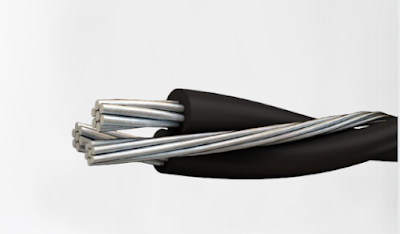What is 3 Core 16mm Armoured Cable Construction?
 |
| Armoured Cable Construction |
The construction of a 3 core 16mm armoured cable involves several components carefully engineered to ensure reliable power transmission and distribution. Here's a detailed breakdown of each component:
1. Conductor:
- The conductor is the core component responsible for carrying electrical current. It is typically made of either copper or aluminum, both known for their excellent conductivity properties.- Copper conductors offer higher conductivity and resistance to corrosion, making them suitable for various applications. Aluminum conductors are lighter and more cost-effective, making them preferred for long-distance power transmission.
2. Cross-Section:
- The cross-section of the conductor refers to the area of the conductor's cross-sectional surface. In the case of a 3 core 16mm armoured cable, the cross-section of each conductor is 16mm².- The 16mm² cross-section allows for sufficient current-carrying capacity while maintaining flexibility and ease of installation.
3. Insulation:
- Insulation materials, such as XLPE (Cross-Linked Polyethylene) or PVC (Polyvinyl Chloride), surround each conductor to provide electrical insulation and protection against moisture, chemicals, and mechanical damage.- XLPE insulation offers superior thermal and mechanical properties compared to PVC insulation, making it suitable for higher voltage and demanding applications.
4. Cores:
- A 3 core cable consists of three insulated conductors bundled together within the cable structure. Each core carries a phase of the electrical circuit, typically designated as phase (L), neutral (N), and earth (E).- The cores are color-coded for easy identification: brown for phase, blue for neutral, and green/yellow for earth.
5. Armouring:
- Armoured cables feature a layer of metallic armour designed to provide mechanical protection against external forces, such as impact, crushing, and abrasion.- The armouring material can be either steel wire or steel tape, applied in one or multiple layers depending on the cable's intended application and operating conditions.
6. Sheath:
- The outer sheath, also known as the jacket, surrounds the insulated cores and armouring layers, providing additional protection against moisture, sunlight, chemicals, and physical damage.- Sheath materials can include PVC, LSZH (Low Smoke Zero Halogen), or PE (Polyethylene), chosen based on factors such as environmental conditions, flame retardancy requirements, and regulatory standards.
7. Voltage Rating and Standards:
- 3 core 16mm armoured cables are available with different voltage ratings to suit various power distribution systems and applications, including 0.6/1kV, 6.6kV, 12/20kV, 11kV, 15kV, and 33kV.- These cables comply with international standards such as IEC 60502, BS 7870, GB/T12706, ensuring quality, performance, and safety in power transmission and distribution networks.
Certainly, here are further details on the construction of a 3 core 16mm armoured cable:
8. Stranding:
- Conductor strands are typically twisted together to form a solid conductor or multiple strands, depending on the cable's flexibility requirements. Stranding improves the cable's flexibility, making it easier to handle during installation and reducing the risk of conductor breakage.9. Fillers and Binders:
- In some cable constructions, fillers and binders may be added between the cores and/or around the armouring to provide additional support, stability, and protection. Fillers help maintain the shape of the cable while binders secure the components in place, preventing movement and ensuring uniform distribution of forces.10. Ripcord:
- A ripcord, also known as a rip wire or tear strip, may be incorporated into the cable design to facilitate the removal of the outer sheath during installation. The ripcord is typically a thin, non-conductive string embedded parallel to the cable's axis, allowing installers to strip away the sheath without damaging the underlying components.11. Identification Markings:
- Identification markings, such as printed text or embossed symbols, may be applied to the outer sheath of the cable to indicate key information such as manufacturer's name, cable type, voltage rating, and production date. These markings help installers and maintenance personnel identify and trace cables accurately.12. Testing and Quality Control:
- Throughout the manufacturing process, 3 core 16mm armoured cables undergo rigorous testing and quality control procedures to ensure compliance with industry standards and specifications. Testing may include checks for conductor resistance, insulation resistance, voltage withstand, mechanical strength, and dimensional accuracy.13. Packaging and Handling:
- Once manufactured and tested, the cables are carefully packaged to protect them from damage during storage, transportation, and handling. Packaging materials may include wooden reels, drums, or coils, depending on the cable's length, weight, and application requirements. Proper handling procedures are followed to prevent kinking, twisting, or bending that could compromise the cable's integrity.14. Installation and Commissioning:
- During installation, 3 core 16mm armoured cables are laid according to specific installation guidelines and standards to ensure proper alignment, support, and protection. Installers must follow recommended bending radii, cable routing, and termination practices to avoid damaging the cable and ensure optimal performance once commissioned.In summary, the construction of a 3 core 16mm armoured cable consists of high-quality conductor materials, insulation layers, metallic armouring, and outer sheathing designed to withstand harsh operating conditions and ensure reliable power transmission. By understanding the components and construction of these cables, users can make informed decisions when selecting and installing cables for their specific applications in construction, industrial, mining, transportation, power generation, and other sectors.



Comments
Post a Comment